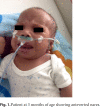Partial Trisomy 13q/Monosomy 3p Resulting from a Paternal Reciprocal 3p;13q Translocation in a Boy with Facial Dysmorphism and Hypertrophic Cardiomyopathy
- PMID: 34602958
- PMCID: PMC8436647
- DOI: 10.1159/000516058
Partial Trisomy 13q/Monosomy 3p Resulting from a Paternal Reciprocal 3p;13q Translocation in a Boy with Facial Dysmorphism and Hypertrophic Cardiomyopathy
Abstract
Individuals with 3p deletion show a great clinical variability. Apparently, a 1.5-Mb terminal deletion, including the CRBN and CNTN4 genes, is sufficient to cause this syndrome. Partial trisomy 13q is a rare chromosomal abnormality with a variable phenotypic expression, but in most cases, patients have a phenotype resembling complete trisomy 13. The aim of the present study is to describe a 9-month-old Mexican male patient with 3p deletion/13q duplication and a novel clinical finding. He presented with facial dysmorphism and multiple congenital alterations. Echocardiogram revealed cardiac insufficiency with hypertrophic cardiomyopathy and pulmonary hypertension, not previously reported. Karyotype from the patient and his father were 46,XY,add(3)(p26) and 46,XY,t(3;13), respectively. Microarray assay of the proband exhibited an approximately 2.6-Mb loss at terminal 3p26.3 and a 27.7-Mb gain of the long arm in terminal chromosome 13 at q31.1q34. A chromosomal imbalance with a partial trisomy 13q31.1q34 and monosomy 3p26.3 of paternal origin were detected. Microarray assay of both parents were normal. The proband has a cardiomyopathy not previously reported. These data enrich the spectrum of clinical manifestations in 3p deletion/3q duplication chromosomopathy.
Keywords: Monosomy 3p; Translocation; Trisomy 13q.
Copyright © 2021 by S. Karger AG, Basel.
Conflict of interest statement
The authors have no conflicts of interest to declare.
Figures



Similar articles
-
Prenatal diagnosis and molecular cytogenetic characterization of de novo partial monosomy 3p (3p26.3→pter) and partial trisomy 16q (16q23.1→qter).Taiwan J Obstet Gynecol. 2016 Apr;55(2):288-92. doi: 10.1016/j.tjog.2016.02.015. Taiwan J Obstet Gynecol. 2016. PMID: 27125417
-
[Phenotypic and genetic analysis of a boy with 3p26.3-pter deletion and 7q31.33-qter duplication].Zhonghua Yi Xue Yi Chuan Xue Za Zhi. 2018 Aug 10;35(4):535-539. doi: 10.3760/cma.j.issn.1003-9406.2018.04.017. Zhonghua Yi Xue Yi Chuan Xue Za Zhi. 2018. PMID: 30098251 Chinese.
-
Familial distal monosomy 3p26.3-pter with trisomy 4q32.2-qter, presenting with progressive ataxia, intellectual disability, and dysmorphic features.Am J Med Genet A. 2012 Jun;158A(6):1442-6. doi: 10.1002/ajmg.a.35345. Epub 2012 May 11. Am J Med Genet A. 2012. PMID: 22581569 Review.
-
Clinical and cytogenetic features of a patient with partial trisomy 8q and partial monosomy 13q delineated by array comparative genomic hybridization.Ann Clin Lab Sci. 2013 Summer;43(3):332-6. Ann Clin Lab Sci. 2013. PMID: 23884231
-
Chromosomal-array analysis reveals partial 11q duplication and partial 12p deletion in a mildly affected case.Am J Med Genet A. 2014 Jul;164A(7):1770-6. doi: 10.1002/ajmg.a.36495. Epub 2014 Mar 26. Am J Med Genet A. 2014. PMID: 24677787 Review.
Cited by
-
Identification of partial trisomy 13q in two unrelated patients using single-nucleotide polymorphism array and literature overview.Mol Cytogenet. 2022 Jul 28;15(1):31. doi: 10.1186/s13039-022-00608-y. Mol Cytogenet. 2022. PMID: 35902965 Free PMC article.
References
-
- Chen C, Lin S, Chen M, Su Y, Chern S, Liu Y, et al. Partial monosomy 3p (3p26.2–>pter) and partial trisomy 5q (5q34–>qter) in a girl with coarctation of the aorta, congenital heart defects, short stature, microcephaly and developmental delay. Genet Couns. 2012a;23((3)):405–13. - PubMed
-
- Chen C, Su Y, Chen C, Su J, Chern S, Town D, et al. Pure partial monosomy 3p (3p25.3 → pter): prenatal diagnosis and array comparative genomic hybridization characterization. Taiwan J Obstet Gynecol. 2012b;51((3)):435–9. - PubMed
Publication types
LinkOut - more resources
Full Text Sources
Miscellaneous

